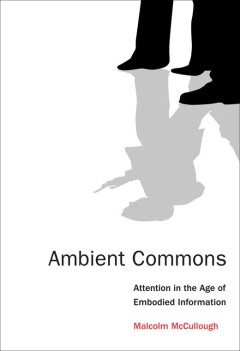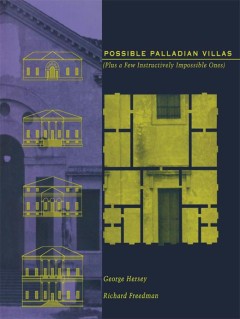Filter by

Ambient Commons: Attention in the Age of Embodied Information
The world is filling with ever more kinds of media, in ever more contexts and formats. Glowing rectangles have become part of the scene; screens, large and small, appear everywhere. Physical locations are increasingly tagged and digitally augmented. Sensors, processors, and memory are not found only in chic smart phones but also built into everyday objects. Amid this flood, your attention pract…
- Edition
- -
- ISBN/ISSN
- 9780262313476
- Collation
- 1 online resource
- Series Title
- -
- Call Number
- -

Possible Palladian villas :(plus a few instructively impossible ones)
Drawing on Palladio's original published legacy of approximately 40 designs, the authors attempt to reveal the rigorous geometric rules by which Palladio conceived these structures. Using a computer, they test each rule in every possible application.OCLC-licensed vendor bibliographic record.
- Edition
- -
- ISBN/ISSN
- 9780262367851
- Collation
- 1 online resource (188 pages) :illustrations.
- Series Title
- -
- Call Number
- -

Why architects still draw :two lectures on architectural drawing
"Why would an architect reach for a pencil when drawing software and AutoCAD are a click away? Use a ruler when 3D scanners and GPS devices are close at hand? In Why Architects Still Draw, Paolo Belardi offers an elegant and ardent defense of drawing by hand as a way of thinking. Belardi is no Luddite; he doesn't urge architects to give up digital devices for watercolors and a measuring tape. R…
- Edition
- -
- ISBN/ISSN
- 9780262321426
- Collation
- 1 online resource (133 pages)
- Series Title
- -
- Call Number
- -

Why architects draw
Examines the social uses of architectural drawing: how it acts to direct architecture; how it helps define what is important about a design; and how it embodies claims about the architect's status and authority. Case study narratives are included with drawings from projects at all stages.OCLC-licensed vendor bibliographic record.
- Edition
- -
- ISBN/ISSN
- 0262367785
- Collation
- 1 online resource (315 pages) :illustrations.
- Series Title
- -
- Call Number
- -
 Computer Science, Information & General Works
Computer Science, Information & General Works  Philosophy & Psychology
Philosophy & Psychology  Religion
Religion  Social Sciences
Social Sciences  Language
Language  Pure Science
Pure Science  Applied Sciences
Applied Sciences  Art & Recreation
Art & Recreation  Literature
Literature  History & Geography
History & Geography